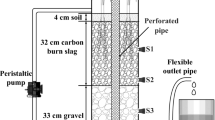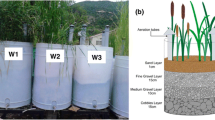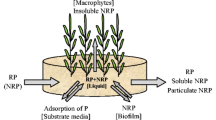Abstract
Nitrogen removal in wetlands is achieved through two pathways: (a) N cycling and (b) storage. N cycling is a permanent removal pathway. There has been an increasing interest in the development of technologies to alleviate permanent nitrogen removal limitation in constructed wetlands by ensuring prevalence of conditions enhancing N cycling. The purpose of this study is to review an emerging technology of vegetated submerged bed constructed wetland system aimed at improving nitrogen removal in wetlands through rational system design. The design and performance of this system type is evaluated. The oxygen transfer capacity and nitrogen removal mechanisms on system performance are evaluated. Constructed wetland combinations most commonly consist of vertical flow (VF) and horizontal flow (HF) beds where VF and HF are aimed at nitrification and denitrification, respectively. Nitrate nitrogen accumulation is the most limiting factor in typical VF based systems.
Similar content being viewed by others
References
Bedford, B. L., Bouldin, D. R., & Beliveau, B. D. (1991). Net oxygen and carbon-dioxide balances in solutions bathing roots of wetland plants. Journal of Ecology, 79, 943–959.
Behrends, L. L. (2006). Integrated constructed wetland systems: Design, operation, and performance of low-cost decentralized wastewater treatment systems. Presented at 7th IWA Speciality Conference on Small Water and Wastewater Systems, Mexico City, Mexico. March 7–10, 2006.
Brix, H. (1990). Gas exchange through the soil–atmosphere interphase and through dead culms of Phragmites australis in a constructed reed bed receiving domestic sewage. Water Research, 24(2), 259–266.
Brix, H. (1997). Do macrophytes play a role in constructed treatment wetlands? Water Science and Technology, 35(5), 11–17.
Brix, H., Arias, C. A., & Johansen, N. H. (2002). BOD and nitrogen removal from municipal wastewater in an experimental two-stage vertical flow constructed wetland with recycling. Paper presented at the 8th International conference on Wetland Treatment for Pollution Control. Arusha, Tanzania.
Brix, H., Arias, C. A., & Johansen, N. H. (2003). Experiments in two-stage constructed wetland system: nitrification capacity and effects of recycling on nitrogen removal. In J. Vymazal (Ed.), Wetlands: nutrients, metals and mass cycling (pp. 237–258). Leiden: Backhuys.
Caffrey, J. M., & Kemp, W. M. (1991). Seasonal and spatial patterns of oxygen production. Respiration and root–rhizome release in Potamogeton perfoliatus L. and Zostera marina L. Aquat Bot, 40(2), 109–128.
Cooper, P. (1999). A review of design and performance of vertical-flow and hybrid reed bed treatment. Water Science and Technology, 40(3), 1–9.
Cooper, P. (2001). Nitrification and denitrification in hybrid constructed wetlands systems. In J. Vymazal (Ed.), Transformations on nutrients in natural and constructed wetlands (pp. 257–270). Leiden: Backhuys.
Cooper, P. F., & Cooper, D. J. (2005). Evaluation of a tidal flow reed bed system for the treatment of domestic sewage—nitrification trials. In J. Vymazal (Ed.), Natural and constructed wetlands-nutrients, metals and management (pp. 222–232). Leiden: Backhuys.
Gries, C., Kappen, L., & Lösch, R. (1990). Mechanisms of flood tolerance in reed, Phragmites australis (Cav.) Trin. ex Steudel. New Phytologist, 114, 589–593.
Kadlec, R. H., & Knight, R. L. (1996). Treatment wetlands. Boca Raton: Lewis.
Kemp, W. M., & Murray, L. (1986). Oxygen release from roots of the submerged macrophyte Potamogeton perfoliatus L.: regulating factors and ecological implications. Aquat Bot, 26, 271–283.
Laber, J., Haberl, R., & Langergraber, G. (2003). Treatment of hospital wastewater with 2-stage constructed wetland system. In R. Haberl & G. Langergraber (Eds.), Achievements and prospects of phytoremediation in Europe (p. 85). Vienna: University of Natural Resources and Applied Life Sciences. Book of abstracts.
Mæhlum, T., & Stålnacke, P. (1999). Removal efficiency of three cold-climate constructed wetlands treating domestic wastewater: effects of temperature, seasons. Loading rates and input concentrations. Water Science and Technology, 40(3), 273–281.
Nakano, M. (1999) Nitrogen removal rate in laboratory scale constructed wetlands. M.S. thesis, Washington State University, Pullman
Obarska-Pempkowiak, H., & Gajewska, M. (2003). The dynamics of processes responsible for transformation of nitrogen compounds in hybrid wetland systems in a temperate climate. In J. Vymasal (Ed.), Wetlands—nutrients, metals, and mass cycling (pp. 129–142). Leiden: Backhuys.
O’Hogain, S. (2003). The design, operation and performance of a municipal hybrid reed bed treatment system. Water Science and Technology, 48(5), 119–126.
Platzer, C., & Mauch, K. (1997). Soil clogging in vertical flow reed beds-mechanisms, parameters, consequences and……solutions? Water Science and Technology, 35(5), 175–181.
Sorrell, B. K., & Armstrong, W. (1994). On the difficulties of measuring oxygen release by root system of wetland plants. Journal of Ecology, 82, 177–183.
US EPA. (1993). Subsurface flow constructed wetlands for wastewater treatment: A technology assessment. EPA 832-R-93-008. Washington, DC: Office of Water.
US EPA. (2000a). Design manual: Constructed wetlands treatment of municipal wastewater. EPA/625/R-99/010. Cincinnati: Office of Research and Development.
US EPA. (2000b). Wastewater technology fact sheet wetlands: Subsurface flow. EPA 832-F-00-023. Washington. DC: Office of Water.
Vymazal, J. (2005). Horizontal sub-surface flow and hybrid constructed wetlands systems for wastewater treatment. Ecological Engineering, 25, 478–490.
Vymazal, J. (2007). Removal of nutrients in various types of constructed wetlands. Science of the Total Environment, 380, 48–65.
White, D. (1995). Enhancement of nitrogen removal in subsurface flow constructed wetlands employing a 2-stage configuration, an unsaturated zone, and recirculation. Water Science and Technology, 32(3), 59–67.
Wu, M.-Y., Franz, E. H., & Chen, S. (2000). Spartina pectinata: A candidate species for constructed treatment wetlands. In S. L. Means & R. E. Hinchee (Eds.), Wetlands and remediation: An international conference (pp. 133–139). Columbus: Batell.
Wu, M.-Y., Franz, E. H., & Chen, S. (2001). Oxygen fluxes and ammonia removal efficiencies in constructed treatment wetlands. Water Environment Research, 73(6), 661–666.
Author information
Authors and Affiliations
Corresponding author
Rights and permissions
About this article
Cite this article
Gaboutloeloe, G.K., Chen, S., Barber, M.E. et al. Combinations of Horizontal and Vertical Flow Constructed Wetlands to Improve Nitrogen Removal. Water Air Soil Pollut: Focus 9, 279–286 (2009). https://doi.org/10.1007/s11267-009-9210-5
Received:
Accepted:
Published:
Issue Date:
DOI: https://doi.org/10.1007/s11267-009-9210-5




